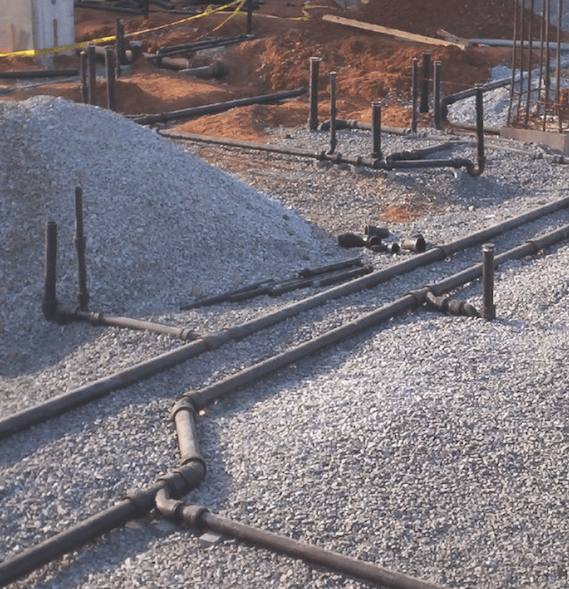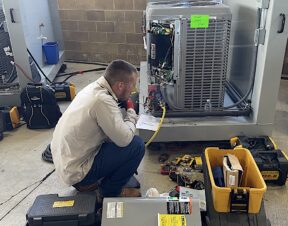“Litigation” is not a word contractors like to hear. Unfortunately, legal proceedings grow every year, affecting contractors, engineers, architects and manufacturers alike. Often times this is due to value engineering of the plumbing system.
Here’s one example. PVC pipe was installed below grade on a new airport in Winnipeg, Canada. Prior to the grand opening, widespread failures of PVC pipe were discovered.The PVC pipe was bowed, bent, crushed, separated or damaged, and much of it was under thick concrete.

One option was to cut the floor and replace the pipe. Many airports utilize Terrazzo flooring, which typically cannot be patched. Another option was to reline the pipe, which is difficult if the pipe has collapsed. A third option was to dig a subterranean trench and replace the pipe. Each was costly, cumbersome and time consuming. The failed system resulted in a twenty-week delay in the opening of the airport as well as litigation that will require years to resolve.
To help avoid lengthy litigation due to value engineering of the plumbing system, here are a few things to consider.
• Cast Iron Soil Pipe has standard charts for crush rating, so trench preparation and backfilling during installation have minimal instructions. PVC pipe has very specific instructions for the dimensions of the trench as well as the bedding and backfill material of the trench. It also has proper backfill methodologies that are outlined in ASTM D 2321.
• Cast Iron Soil Pipe typically requires an endothermic fire stopping material to fill the annular space between the pipe and any fire rated wall or floor penetrations. Fire caulk products are widely used in the construction industry, inexpensive, simple to install and usually have a long life of useful performance. PVC pipe typically requires an intumescent fire stop, which is significantly more expensive than endothermic fire caulk because of the performance and material requirements.
If there are a small number of fire wall penetrations, value engineering to PVC may be a viable alternative. However, if there are a large number of fire wall penetrations it is less viable because of the more expensive system components required.
• If noise is a concern, cast iron soil pipe is the hands-down better choice. Research has shown that cast iron soil pipe is 750% more effective in silencing plumbing noise when compared to PVC.
• Expansion and contraction is generally not a concern with cast iron soil pipe because it expands ¾” per one hundred feet per one hundred degrees Fahrenheit change (approximately the same as concrete). On the other hand PVC will expand and contract approximately 4.5 to 5 times more, often requiring the need for expansion loops, offsets or changes in directions.
These are difficult to use with gravity systems and the calculations required for installation for compensation are difficult for installers to calculate. The calculation is ΔL = LpC Δ, where: ΔL = Change in length due to change in temperature (in.), Lp = Length of pipe (in.), C = Coefficient of thermal expansion (in./in./°F) = 3.8 x 10-5in./in./°F for PVC ΔT = Change in temperature (°F).
• Another factor to consider when calculating expansion loops is any space limitations your project may have. Often it is very difficult to find the space necessary in order to install properly sized loops and/or offsets. Depending on the project, there may be no space to add the proper loops for expansion and contraction.
• Cast iron soil pipe requires hanger/support within every 18 inches of a coupling or hub. Hanger spacing for PVC and other plastics requires a thoughtful evaluation of pipe size relative to the operating temperature. For instance a four-inch PVC pipe operating at 60⁰ F will require hangers every 7.5 feet and at 140⁰ F every 4 feet.
• Elevated temperatures can cause a PVC system to fail. PVC is rated at a maximum temperature of 140⁰ F while Cast Iron Soil Pipe is rated at 212⁰ F. While many systems have controls limiting the maximum temperature in a system, this is not a guarantee against failure. Consider if the system can be manipulated to override max limits. Also, remember that quick-cure concrete can exceed 140⁰ F and that autoclave or boiler condensate may be errantly drained into the system.
Here’s another case study. The specs for a Midwestern hospital called for cast iron underground, but it was value engineered to PVC. From a budget standpoint this looked like a good idea, since it offered a $5,000 savings on a $20,000 project. Unfortunately, the boiler contractor dumped 180⁰ F condensate into the system causing the PVC to fail. This led to a $29,000 bill to fix the failed piping system.
For more information on value engineering and plumbing systems visit www.charlottepipe.com/value_engineering.
Written by: Paul Riedinger, LEED AP BD+C




Join the conversation: